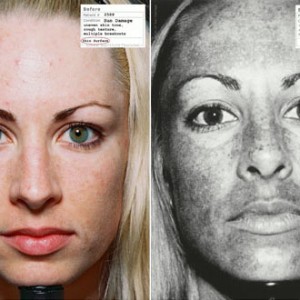
In August, the FDA announced it was revising sunscreen guidelines to make the products more user-friendly and accurate for consumers. These changes will go into effect next month on December 17, altering the way lotions and sprays are labeled. Here’s what you need to know when selecting sun protection.
Skin cancer is the most common cancer in the US and rates continue to rise. Melanoma is incredibly deadly, and it’s less lethal counterparts, squamous and basal cell carcinomas, can potentially be disfiguring, especially if they are on the face or neck. What’s more, sun exposure is the primary cause of aging. Don’t believe just how much sun exposure can wreak havoc on your skin? Just look at this infamous photo of a truck drivers whose left side was exposed to the sun through the driver’s side window. The difference is clear.
Skin Thickening and Deep Wrinkles Caused By Sun Expsoure
First of all, creams will now be required to only label themselves as “Broad Spectrum” if they protect against both UVA and UVB rays. UVA is primarily responsible for skin cancer and aging, and is at the same intensity in January and is it is June. This is why wearing sunscreen year-round is so important! UVB is known for causing sunburns. A combination of the two is essential. After December 17, if your sun defense product does not say “broad spectrum” it isn’t offering you complete protection from the rays that damage the skin.
Sunscreens will also now be required to label themselves as waterproof only if they pass specific and standard tests. If they are in fact water and sweat resistant, they will say “40″ or “80″ indicating the amount of minutes your skin is safe until you need to reapply. Products will no longer be allowed to label themselves a “waterproof” or “sweatproof” as this is a misnomer and gives consumers a false understanding of their ability.
Sun Damage Doesn’t Always Appear On the Surface…Yet
Finally, sunscreens will no longer be able to refer to themselves as “sunblock” as this is inaccurate, and the highest SPF will be “50+.” This is because clinical studies have found little benefit to increasing SPF numbers after 50. Additionally, products under SPF 15 will no longer be able to call themselves “sunscreen” as they truly don’t offer enough protection to be labeled as such.
As winter approaches, be aware that any outdoor light has the potential to penetrate the skin, whether it is cloudy, snowing, or bright outdoors. Preventing the damage is the easiest and most effective way to combat aging and skin cancer. Look for products that label themselves “broad spectrum,” and that offer a thin non-greasy, non-comedogenic formula.
My office offers a variety of high-quality sun-defense products that you can purchase at any time. Some of my favorites are the RevaleSkin Day Cream with SPF 15: http://www.skinlabsmd.com/revaleskin-day-cream-with-spf-15-sunscreen/ or the NIA 24 Sun Damage Prevention 100% Mineral SPF 30 Sunscreen: http://www.skinlabsmd.com/nia-24-sun-damage-prevention-100-mineral-sunscreen-spf-30/

 Dr. Rokhsar was chosen by
Dr. Rokhsar was chosen by 








